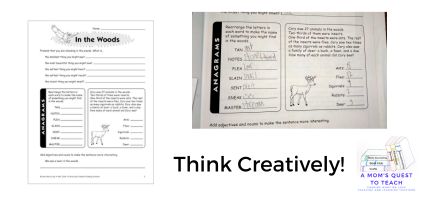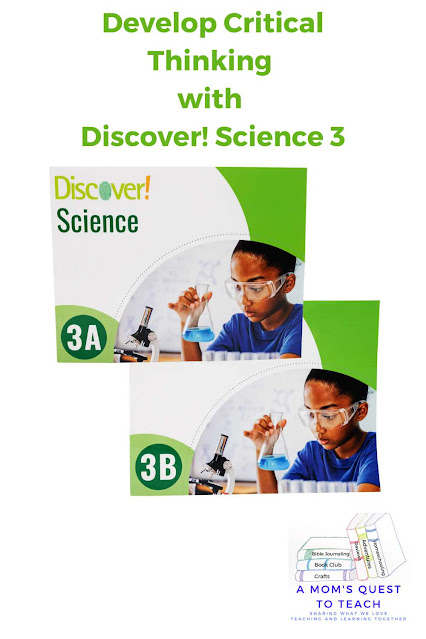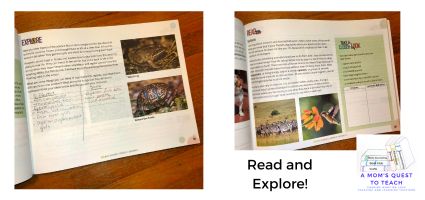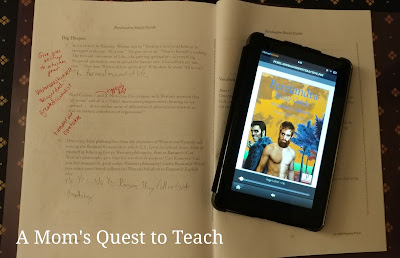No matter where your homeschooling journey may take you and your high school students – such as taking standardized tests like the PSAT or the SAT – building vocabulary skills is always important. Our tenth grade high school student has spent most of the year taking a literature-based language arts course. So when the opportunity arose to review
Vocabulary Virtuoso PSAT-SAT Book 1 (Grades 8-12+) from
The Critical Thinking Co. I knew it would be a great fit for us. It is a 204-page paperback book (it is also available in eBook form) with twenty vocabulary lists and lots of different activities to help students learn the vocabulary words.
What is Vocabulary Virtuoso?
Vocabulary Virtuoso PSAT-SAT Book 1 (Grades 8-12+) from
The Critical Thinking Co. contains nine sets of vocabulary words in twenty lessons. "85% of all the words are from current PSAT or SAT lists" (Introduction). The vocabulary lists include a pronunciation key, definition, other forms of the word, and a sentence using the word in context. There are a variety of activities included to provide students a chance to use the words in context as well as a story in each lesson. The stories take place in a fictional classroom where students learn the following concepts:
Literary

- Characterization in literature
- Idioms
- Puns
- Jargon
- Irony
- Euphemisms
- Aphorisms
- Allusions
- Theme
Rhetorical
- The art of persuasion in speech and writing
- Using extended simile to write a poem
Historical
- The Renaissance
- Renaissance Artists
You can even see some
sample pages on The Critical Thinking Co.'s website. This sample includes the table of contents and exercises for Vocabulary List 1. What a great way to see if the book will be a fit for your family!
How We Are Using Vocabulary Virtuoso
Each vocabulary list and corresponding activities can be spread out nicely over the course of one week. On Monday, I ask our son to create note cards with the vocabulary words and definitions provided or ones from a dictionary if he needs a different one to more clearly understand the word. I also ask him to complete Part A (for the the first four lists, Part A asks the student to choose the best word to complete each sentence).
On Tuesday, I ask our tenth grader to complete parts B and C. For the first four lists, Part B asks students to choose the best word to complete the sentence while Part C is a Story Challenge. Students read through the story and fill in the blanks using the vocabulary words. The Story Challenges also provide useful information. For example, for Vocabulary List 3, the Story Challenge addressed idioms while using words from the list like obfuscate, justify, and malign.
Parts D & E are completed by our high school student on Wednesday. These two parts have been similar to those in the first section. Part D directions are: "The underlined part in each sentence is a synonym, idiom, phrase, or definition for a list word. Unscramble the list word and write the word on the blank." One of the sentences is: "In a debate, with good reasons, Christopher
defended his position that the school should adopt a uniform dress code." (justify being the correct answer) Part E asks students to choose the word, idiom, or phrase from the box that best defines each list word. For List Four Part E includes one word in the choice box, effervescent, which was in Vocabulary List 1 to match with ebullient.
Finally, Part F is completed. Throughout the book Part F asks students to "Complete each sentence to show that you understand the meaning of the underlined word." For example, here is one of our son's sentences: "Because he had been
frugal with money he earned and received as a gift, Dylan
bought a decent car at 18."
At the end of each week, I created a short vocabulary quiz (10 to 15 questions in length) using some of the questions from the book in addition to some I created myself. We are counting his work in Vocabulary Virtuoso PSAT-SAT Book 1 and the quizzes for his American Lit course.
At the conclusion of each section, there are review lists (for five review lists in total). There is a crossword puzzle, sentence completion, and matching questions. When reviewing Lists 5-8, our son will have to match vocabulary words with fictional book titles – what a neat idea to help build vocab skills!
What Does Our Teen Think?
When talking with our teen while he was completing the review activities for lists 1-4, I asked him what he liked about Vocabulary Virtuoso. He said he really liked the format of the book. It is clean and concise and easy to look at while working on the activities. The way the information is presented suits the way he learns. For example, he explained he does not like the way most textbooks are organized with main text, boxed secondary information, and information set into separate parts. He prefers something that is straightforward in layout.
He appreciates the variety of activities so that while he is working on each list he does not feel bored. His least favorite activity is the last one where he needs to complete the sentences. He said sometimes it is harder to figure out an ending for the sentence than other times. (I think this means his brain is working to make sure that he demonstrates he understands the vocabulary word!)
In the Future
We may take a break from working with
Vocabulary Virtuoso PSAT-SAT Book 1 during the summer, but I see us completing the work in our next homeschool year in a similar fashion – one list per week. I even hope to ask our son to include the vocabulary words in his other course work – when writing essays, letters, notes, etc. This is a perfect way to ensure he is absorbing and utilizing all these excellent words.
And since our teen seems to enjoy working with Vocabulary Virtuoso, I see this being a good fit in the upcoming homeschooling year and in the future with Book 2.
And while we are unsure as to whether not our son plans on taking the SAT (his future plans after completing high school are still undecided), I am definitely glad we are using Vocabulary Virtuoso PSAT-SAT Book 1 (Grades 8-12+) as building a good vocabulary is important in a variety of careers, professions, and educational paths.
Notes and Observations
Our teen sometimes completes all the work on one day – he prefers to complete work that doesn't need a computer done at one time – so there is no reason why each set of vocabulary would need to take an entire week. I think it all depends on what you and your children are doing in your homeschool. This makes Vocabulary Virtuous a great addition because it can be used in a variety of ways.
I like how each list can build upon the previous lists and that even within the different activities there are words that may challenge a student.
There are answer keys at the back of the book which you may choose to remove from the book to ensure your child completes all the work on their own. There is also a sample activity from
Critical Thinking Detective TM – Vocabulary Book 1. (This looks like another great resource!)
If you are interested in learning more about The Critical Thinking Co., please be sure to check out the following sites:
And if you are interested in purchasing any of their products...use the code TOSCREW19 to receive Free Shipping and 15% off any size order! This code (TOSCREW19) expires 12/31/2019.
And be sure to check out all the other
reviews – The Critical Thinking Co. publishes many great products! From a book of 20
Elementary Math Games to works that will help your children build
writing skills. The Critical Thinking Co. might have the perfect resource for your homeschool.


.jpg)
.jpg)

.jpg)
.jpg)







.jpg)
.png)
%20(1).png)
.png)
.png)
.png)
.png)

.png)
.png)
%202%20new.png)



























